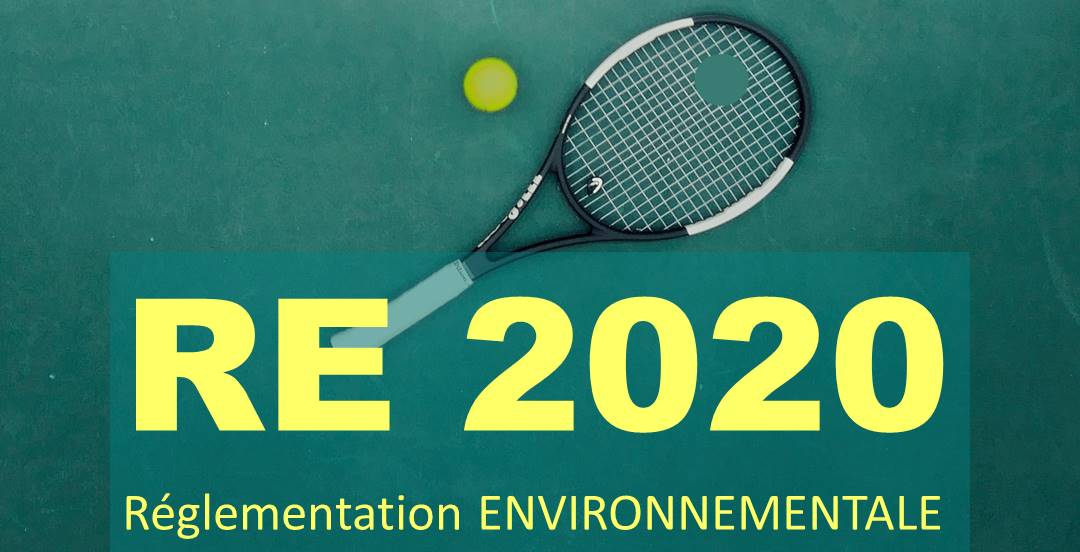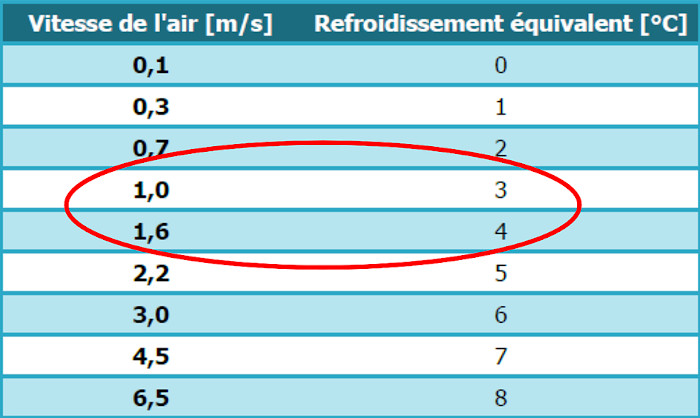Air movers and RE2020: holes in the racket?
What are these beneficial impacts that remain to be integrated into the RE2020?
Over-ventilation at night: no coupling with fans planned
This oversight is regrettable. The effectiveness of night-time over-ventilation for summer comfort has been widely demonstrated and is taken into account in the regulations.
Two solutions allow for over-ventilation at night:
- equipment for the automatic opening of windows (natural over-ventilation), e.g. with cylinders or servomotors. Naturally, the management of the risks of intrusion, strong winds or rain penetration must be integrated.
- mechanical night ventilation systems[2]
In the first case, air movers are relevant in the absence of wind.
In the second case, the air movement rates [3]rarely exceed 6 vol/h. However, air blowers generally deliver a rate of over 70 vol/h.
The coupling between the fans and night-time ventilation leads to a faster cooling of a room, with a beneficial impact on summer comfort, and a very low level of energy consumption. It would be desirable in the long run to integrate this beneficial combination.
[2] Controlled mechanical ventilation – single or double flow, air handling unit… Hybrid systems between natural and mechanical ventilation can also be implemented
[3] Hourly turnover rate: number of times the air volume in a room is changed per hour
Winter comfort is not addressed in the RE2020
In winter, in rooms equipped with wood-burning stoves, temperatures can rise very quickly in certain areas. However, air blowers can improve comfort by homogenising the air in the room at low speed. With the RE2020, summer comfort has taken a big step forward, but winter comfort still needs to be built.
Energy gains from air movers in air-conditioned buildings are overlooked
The texts stipulate that air movers will contribute to summer comfort only in buildings that can avoid air conditioning. However, in buildings equipped with air conditioning, the presence of ceiling fans could have two virtuous effects.
Firstly, the length of the cooling season could be shortened. The summer comfort without air conditioning is maintained longer, so only in the hottest period should the air conditioning be activated. Then, the improvement in thermal comfort linked to the increase in air speed (up to 4°C gain in perceived temperature) makes it possible to increase the air conditioning set point.
The diagram below shows the considerable gain in comfort due to the increased air velocity provided by the ceiling fans.
On this occasion, it should be recalled that hygrometry is not taken into account in the parameters of summer comfort in the RE2020.
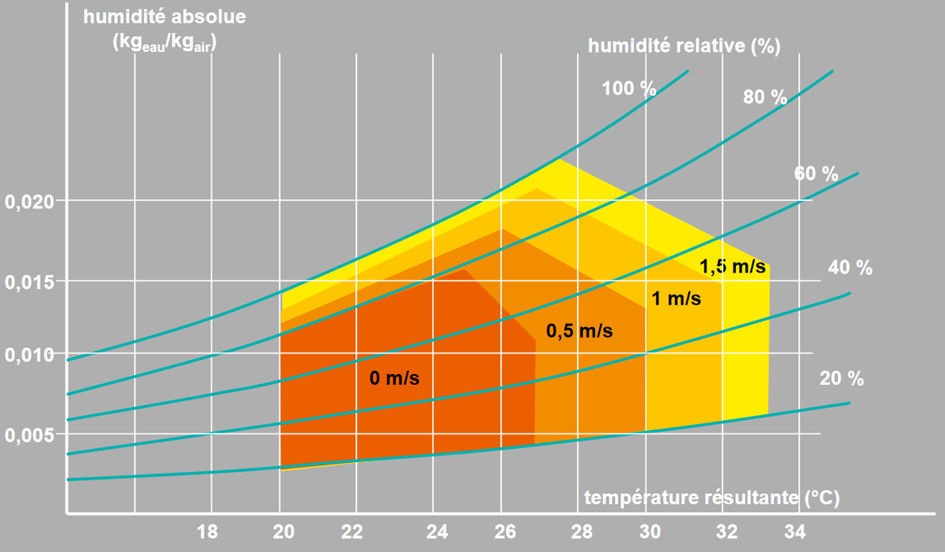
Givoni diagram, Energy Tribe
By shortening the cooling season on the one hand and increasing the cooling set point on the other, the energy savings are considerable. An American study mentions a gain in energy consumption of 7 to 10% per degree of set point.
Values taken from the Woods Practical Ventilation Guide, valid for average humidity and clothing conditions in summer.
For example, by increasing the air-conditioning setpoint from 24 to 28°C, energy consumption can be reduced by 30 to 40% while maintaining the highest level of user comfort.
The beneficial impact of winter destratification in terms of energy consumption is not included in the RE2020
In a room, warm air is less dense than cold air: warm air rises and cold air stagnates at ground level. The temperature variation can reach 1°C per metre of height. This is the phenomenon of stratification.
Destratification allows the temperature to be homogenised between the upper and lower parts of the room.
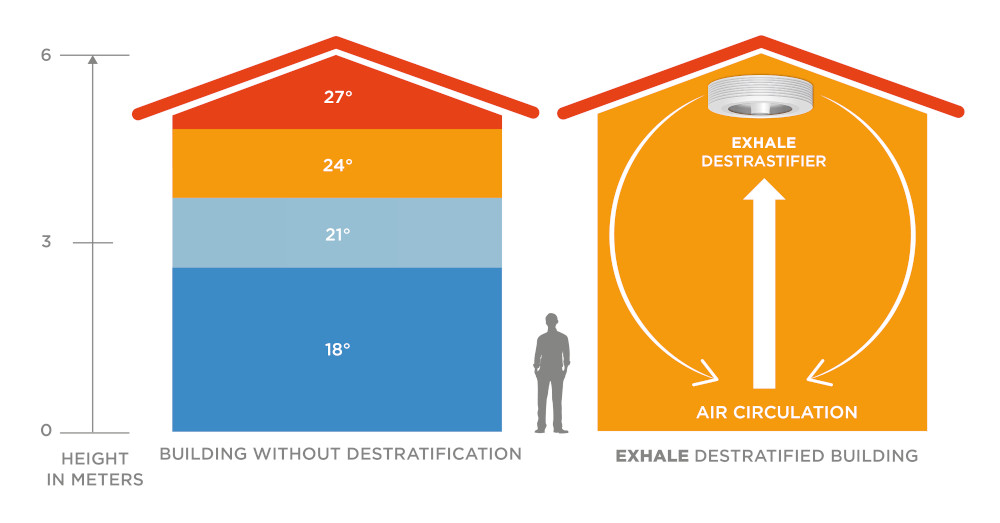
Illustration of the destratification phenomenon – Exhale Fans
It has been established that for high-rise commercial and industrial buildings, destratification during the heating season can result in significant energy savings.
This is established by two energy saving certificates, one for industry, and one for the tertiary sector..
EDF (Electricity of France) has also published a study confirming a gain of up to 30% in terms of winter energy consumption.
This type of scheme also works in single-family homes, especially for cathedral ceilings. This is because the heat is homogenised throughout the room, instead of being concentrated mainly in the ceiling.
RE2020: one more effort
Part of the journey has been made for the air movers. Of course, we need to go further. Because the widespread use of air movers helps to limit the use of air conditioning. The impact is multiple: comfort in buildings, limitation of urban heat islands in cities, reduction of greenhouse gas emissions, and a significant reduction in energy consumption.
In short, I am looking forward to an “air blower” bonus, just as there is already a bonus for electric bikes!
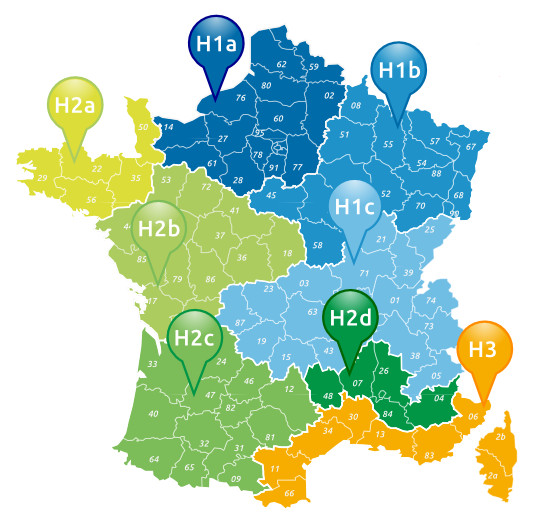
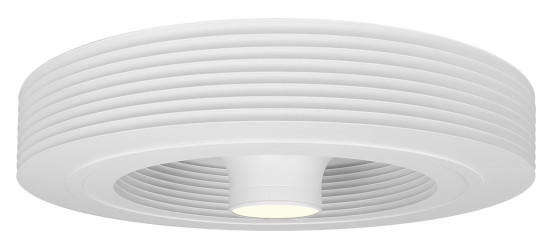
Exhale the first vortex bladeless ceiling fan
You are a professional. A specific space is dedicated to you.
Find Exhale Fans Europe on Linkedin

